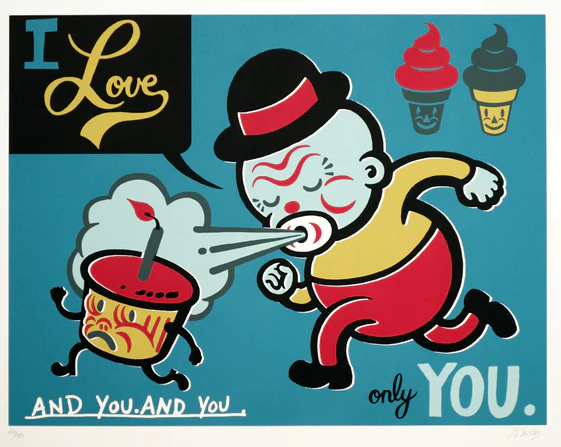
Text Type Words & Sayings

Gary Taxali I Love Only You Silkscreen Print by Gary Taxali
I Love Only You Silkscreen Print by Gary Taxali Hand-Pulled 6-Color on Cover White Arches Fine Art Paper Limited Edition Artwork. 2014 Signed & Numbered Limited Edition of 50 Artwork Size 29x23 Silkscreen Print The Significance and Craft of Gary Taxali's "I Love Only You" Silkscreen Print Gary Taxali's "I Love Only You" silkscreen print is a vibrant example of contemporary Street Pop Art and graffiti Artwork. This limited edition piece, created in 2014, demonstrates Taxali's unique blend of vintage comic strips, advertising aesthetics, and playful imagery that firmly roots his work in the legacy of Pop Art while pushing its boundaries into the street and graffiti art scenes. Taxali, known for his distinctive style, often marries the retro with the modern, and this artwork is no exception. It is a hand-pulled 6-color print on Cover White Arches Fine Art Paper, a choice that speaks to the artist's dedication to craftsmanship and quality. Arches Paper is revered among artists for its texture and durability, serving as a testament to its longevity and collectibility. The limited-edition nature of "I Love Only You," with only 50 signed and numbered prints, increases its exclusivity and desirability among collectors. The artwork's approximately 29x23 inches size makes it a substantial piece suitable for prominent display. Silkscreen printing, a method famously used by Pop Art icon Andy Warhol, allows Taxali to achieve vivid colors and sharp images that are striking and emotionally resonant. Exploring the Pop Art Continuum in Street Art through Taxa li's Work Gary Taxali's work is often celebrated for its ability to capture the spirit of Pop Art and transpose it onto the more raw and expressive canvas of street art. "I Love Only You" exemplifies this cross-pollination. The subject matter—a whimsical character engaging directly with an inanimate object, infusing it with affection and personality—encapsulates the heart of Pop Art's interest in the mundane and the commercial. However, Taxali's bold lines and the print's presence as a piece of Street Pop Art and graffiti Artwork also evoke the unrefined, immediate quality of street art and graffiti. Taxali's characters are reminiscent of 1930s cartoons, yet they carry a contemporary edge that speaks to today's audience. The playful nature of the piece, combined with its direct and simple message, is characteristic of street art's ability to communicate with a broad audience. This overlap of high art and low art, of gallery walls and street corners, is a defining feature of Taxali's artistic practice and places "I Love Only You" within the ongoing dialogue of art as a public and personal experience. Cultural and Artistic Value of Taxali's Silkscreen Print "I Love Only You" not only represents a blend of artistic styles but also embodies a cultural statement that resonates with the ethos of Pop and Street Art. Both movements have often sought to blur the lines between 'high' and 'low' culture, and Taxali's print contributes to this discourse. It juxtaposes commercial art techniques with acceptable art practices, suggesting that art can be both accessible and sophisticated. Taxali's print holds an esteemed place in the art world for its aesthetic appeal and commentary on love, consumerism, and the interplay of text and image. The phrase "I Love Only You," juxtaposed with various objects, speaks to the commodification of emotions and relationships, a theme frequently explored in pop and street art. By presenting this commentary through silkscreen—a technique associated with mass production—Taxali underscores the tension between uniqueness and ubiquity, a conversation ever-present in public art discussions. The Enduring Appeal of Gary Taxali's "I Love Only You" Gary Taxali's "I Love Only You" is a testament to the artist's role as a bridge between past and present, fine art and street culture. Through his meticulous crafting of this print and careful selection of medium, Taxali has created a piece that is visually captivating and rich in meaning and context. As a piece of Street Pop Art and graffiti Artwork, it continues to engage viewers, spark conversations, and hold a mirror to the culture it both represents and critiques. The rarity and handcrafted nature of the print further cement its status as a desirable collector's item, embodying the spirit of both Pop Art and the irreverent, democratic ethos of street and graffiti art. In "I Love Only You," Taxali has captured a moment in art history while contributing to its evolution.
$600.00


